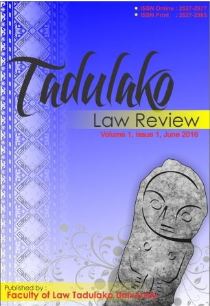EXISTENCE AND CHANGES IN THE MATERIAL JURISDICTION OF MINANGKABAU CRIMINAL COURTS IN WEST SUMATERA
Keywords:
Customary Law, Criminal, Court, MinangkabauAbstract
Indonesia is a country with various ethnic composition of the population. Each of these ethnic groups or tribes certainly has its customary or adat law that is different from one another. The ethnic group that still maintains the validity and norms of its customary law is known as customary law community. One of the unique and well-known customary law communities in Indonesia is the Minangkabau customary law community. The majority of its members inhabit the province of West Sumatra. Minangkabau Customary Law not only regulates the civil cases that arise in that law community, but also the criminal ones. In the event of a criminal case, the settlement is carried out through the mechanism of the customary criminal court. The material jurisdiction of the Minangkabau Customary Criminal Court is regulated in a law called “the Nan Salapan Law” (the eight law). After the issuance of the Emergency Law Number 1 of 1951, the material jurisdiction of the Minangkabau Customary Criminal Court was narrowed down to cases that had no equal in the Criminal Code and those that were comparable in the Criminal Code with the same criminal threat. However, in practice, in recent years, there has been a contradiction where this customary criminal court no longer follows the provisions of the Emergency Law Number 1 of 1951. The scope of the material jurisdiction of this customary criminal court has undergone a significant change. This court not only adjudicates criminal cases that have no equal in the Criminal Code but also adjudicates cases regulated in criminal legislation outside the Criminal Code, such as cases of sexual abuse, narcotic abuse, and criminal acts of domestic violence (KDRT). The author in this article seeks to examine and elaborate further on what things affect the changes in the material jurisdiction of the Minangkabau customary criminal court and what are the views of Minangkabau traditional leaders and law enforcement officials, especially the police and judges, in responding to these changes.
References
Bewa Ragawino, (2008), Pengantar Dan Azas-Azas Hukum Adat Indonesia, Bandung: Fisip Unpad,
M. Rasjid Manggih Dt. Rajo Panghoeloe, (1982), Sejarah Ringkas Minangkabau Dan Adatnya, Jakarta, Penerbit Mutiara
Ibrahim Dt. Sanggoeno Diradjo, (2009), Tambo Alam Minangkabau Tatanan Adat Warisan Nenek Moyang Orang Minang, Bukittinggi: Kristal Multimedia
Idris Hakimy Dt. Radjo Penghulu, (1986), Pokok-Pokok Pengetahuan Adat Alam Minangkabau, Bandung, CV Remaja Karya
AM. Datuak Maruhun Batuah & DH. Bagindo Tanameh, (1955), Hukum Adat Dan Adat Minangkabau, Djakarta, NV, Poesaka Aseli
Suardi Mahyuddin & Rustam Rahman, (2002), Hukum Adat Minangkabau Dalam Sejarah Perkembangan Nagari Rao-Rao, Jakarta, CV Citatama Mandiri
Herlambang P. Wiratraman, (2018), Perkembangan Politik Hukum Peradilan Adat, Mimbar Hukum, Vol. 30, No. 3
Jeffrey Hadler, (2010), Sengketa Tiada Putus; Matriarkat, Reformisme Islam, Dan Kolonialisme Di Minangkabau, Jakarta, Freedom Institute






